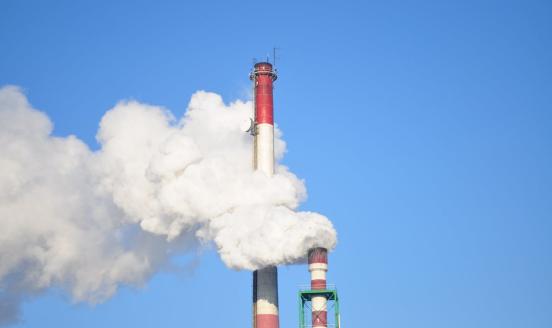Climate change and financial markets
What’s at stake: Ever since the 2016 Paris Agreement to reduce emissions was signed, researchers have been looking at the impact that moves towards a
In February 2016, the ESRB published a report estimating the impact of a transition to clean energy on financial markets. Keeping global warming below 2°C - as agreed in Paris - will require substantial reductions in global greenhouse gas emissions over the next few decades. To reduce emissions, economies must reduce their carbon intensity. Given current technology, this implies a decisive shift away from fossil-fuel energy and related physical capital.
The ESRB argues that if the transition were to occur too late and/or abruptly, it could affect systemic risk via three main channels:
(i) the macroeconomic impact of sudden changes in energy use
(ii) the sudden revaluation of carbon-intensive assets
(iii) a rise in the incidence of natural catastrophes
To quantify the importance of these channels, the ESRB report proposed that policymakers aim for enhanced disclosure of the carbon intensity of non-financial firms. They called for the related exposures of financial firms be stress-tested under the adverse scenario of a late and sudden transition.
Using a sample of firms that covers the full range of carbon intensity from renewable energy firms to coal firms, Sowerbutts examines the effect of the Paris agreement on their returns in the framework of an event study. Comparing the cumulative abnormal returns experienced by a petroleum refining company (CVR Energy) and a wind turbine manufacturing company (Nordex) in the immediate aftermath of the announcement of the Paris Agreement on 12 December 2015, he finds that the reaction was immediate and persistent. Prices jumped immediately on the first trading day, meaning a positive abnormal return of 4% for Nordex and a negative abnormal return of 4% for CVR energy, with gradual declines to end up at a cumulative abnormal return of 6% over the whole period (see figure below).
Baranova, Jung and Noss argue that there is a risk that adjustment in financial market prices will be abrupt and likely to pose risks to financial stability, because financial valuations can move sharply even if the transition to sustainable energy were smooth. They argue that exposures are sufficiently large to warrant attention from both investors and policymakers. Using scenarios for carbon emission limits, they assess their impact on different industrial sectors and the consequent effect on financial asset valuation.
Their computations yield a large re-pricing of energy stocks: even under a smooth transition, affected firms’ equities would lose around 40% of value, equivalent to a fall of around 11% in global equity market capitalisation. If this were to happen rapidly, such a re-pricing could pose financial stability risk. Turning to credit markets, the most affected companies have earnings that would likely be sufficient to service interest payments on their existing debt even in the case of a significant fall in revenues. But if the shock to revenues/profits were permanent – as might be the case under the crystallisation of climate transition risks that posed a longer-term risk to the viability of some firms – a rise in refinancing costs could ultimately result in an increase in defaults, with associated implications for financial stability.
Battiston et al. (2016) propose a novel methodological framework to assess the exposure of the financial system to climate policy risks. They aim to capture both the direct effects on the fossil fuel production sector and the indirect effects on key economic sectors such as energy-intensive sectors, housing and finance. Using empirical data from the euro area, they show that while direct exposures to the fossil fuel sector are small (3-12%), the combined exposures to climate-policy relevant sectors are large (40-54%), heterogeneous, and possibly amplified by indirect exposures via financial counterparties (30-40%). These results suggest that climate policies could result in potential winners and losers across financial actors. However, they would not have an adverse systemic impact as long as they are implemented early on and within a stable framework.
An external report commissioned by the German Finance Ministry builds on the same framework. It indicates that the direct physical effects of climate change are highly unlikely to pose a risk to the stability of German and European financial markets over the short to medium term (up to 2030), but transition risks are higher. Emissions-intensive industries make up a major part of German industry. In fact, emissions-intensive companies in the chemical (20%), industrial goods and services (13%), automotive (14%) and utilities (3%) sectors account for nearly half of the DAX 30 index. The report estimates that transition risks are likely to cause financial market assets (equity and bonds) to lose a maximum of 2%–5% of their value, meaning that such risks by themselves pose a minor risk to financial market stability. However, depending on the structural characteristics of the financial system, there could be secondary effects - combined with other downside risks - that could very well lead to serious repercussions and cumulative risks.
Dietz et al. take a different point of view and ask a different question: what might be the impact of climate change itself on asset values? They find that the expected ‘climate value at risk’ (climate VaR) of global financial assets today is 1.8% along a business-as-usual emissions path. Taking a representative estimate of global financial assets, this amounts to US$2.5 trillion. However, much of the risk is in the tail. For example, the 99th percentile climate VaR is 16.9%, or US$24.2 trillion. These estimates would constitute a substantial write-down in the fundamental value of financial assets. Cutting emissions to limit warming to no more than 2 °C reduces the climate VaR by an expected 0.6 percentage points, and the 99th percentile reduction is 7.7 percentage points. Including mitigation costs, the present value of global financial assets is an expected 0.2% higher when warming is limited to no more than 2 °C, compared with business as usual. The 99th percentile is 9.1% higher. Limiting warming to no more than 2 °C thus makes financial sense to risk-neutral investors—and even more so to the risk averse.
In a speech given for the Arthur Burns Memorial Lecture, Mark Carney highlighted paradoxes in addressing the financial risk from climate change. The first paradox is that “the future will be past”: climate change imposes a cost on future generations that the current one has no direct incentive to fix and once climate change becomes a clear and present danger to financial stability it may already be too late to stabilise the atmosphere at two degrees. The second paradox is that “success is failure”: a too rapid a movement towards a low-carbon economy could materially damage financial stability. Carney stressed that smooth adjustment is crucial because transition risks are how success could turn into failure, and that an obstacle to a smooth adjustment has been the absence of information to help market participants make a market in climate-related financial risk.



